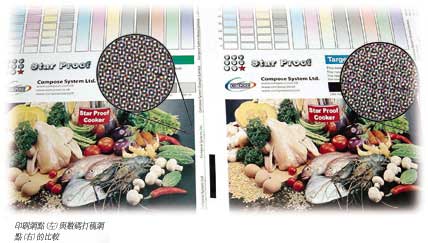Digital writing is a hot topic in the industry recently. However, most of the current systems are asynchronous and lack synchronization. The so-called asynchronous processing is to use a dedicated RIP for digital profiling processing, and when outputting film or direct-to-plate (CtP), another RIP is used for processing. When exporting film or direct platemaking, problems such as missing characters, overprint, low resolution images, and RGB images cannot be checked in these systems. In addition, most digital copying systems currently use FM screening, which can only be used for color comparisons. It is not possible to check if there are any errors in the outlets.

Recently, I heard that there was a colleague in the industry who had been using asynchronous digital prototyping and then went straight out of the zinc printing. Until one time when the Haute Couture catalog was printed, it was not possible to verify the status quo of GuiZhou due to the inconsistency between the pattern and the angle of photography due to asynchronous digital proofreading. It was returned in full and suffered heavy losses.
 The word "ROOM once Output Many" was recently appeared in the industry. Only one processing by a raster processor can be output to a variety of different output devices. Such as photosetters, direct platesetters or color inkjets. Because there is only one processing, once there is a missing word or overprint, it can be checked on the digital copy. Such as the Delta system in Heidelberg and the Angel/Angel CT/LW system. However, these systems still fail to synchronize with the outlets. They can only match colors and cannot check outlets. Nowadays, the direct plate making system is becoming popular and the demand for digital manuscripts has greatly increased. What the industry is eager for is the true ROOM and digital copying system that can look at outlets.
The word "ROOM once Output Many" was recently appeared in the industry. Only one processing by a raster processor can be output to a variety of different output devices. Such as photosetters, direct platesetters or color inkjets. Because there is only one processing, once there is a missing word or overprint, it can be checked on the digital copy. Such as the Delta system in Heidelberg and the Angel/Angel CT/LW system. However, these systems still fail to synchronize with the outlets. They can only match colors and cannot check outlets. Nowadays, the direct plate making system is becoming popular and the demand for digital manuscripts has greatly increased. What the industry is eager for is the true ROOM and digital copying system that can look at outlets.
The introduction to the industry is the Compose System's Star Proof digital dot-printing system. This system runs on OSX on the Apple Macintosh. Accepts 1-bittiff four-color dot-matrix files generated by Harlequin RIP, Agfa Taipan RIP, Dainippon Screen Pixel Stream, or Other RIP. Can support CCITTG4, CCITTG3, CCITTHuffmanRLE, Packbit and other compression formats. Star Proof uses true dot-swap technology and can transfer up to 200 lpi dots to the Epson Stylus Pro 10000 for printing with the Epson Stylus Pro10000's Variable Print Point Technology (VSDT). When the 1-bittiff four-color dot matrix file produced by the above-mentioned RIP is sent to the Hot Folder of Star Proof, it immediately packs, processes, calculates and converts the four-color dot matrix file into a color inkjet signal. After printing by the color ink jet printer, the 1-bittiff four-color dot matrix file can be output to the photosetter or the plate-setter directly after checking. Because it is the same set of 1-bittiff data synchronous output (ROOM), plus real network point transfer, all the printing effects can be demonstrated in digital printing to ensure that there will be no error.
 StarProof's unique color management system uses the concept of traditional electric extension color correction to simply and effectively adjust the ink jet color to the same color as the printing color. Only one spectrodensitometer is needed to measure the printed and drafted sheets. CMYK The three-point density of 100%, 80%, and 40% per color, and then input into the system, the system will automatically calculate, the color correction to close to the printing color. Then through fine-tuning, it can reach the same color as the printing.
StarProof's unique color management system uses the concept of traditional electric extension color correction to simply and effectively adjust the ink jet color to the same color as the printing color. Only one spectrodensitometer is needed to measure the printed and drafted sheets. CMYK The three-point density of 100%, 80%, and 40% per color, and then input into the system, the system will automatically calculate, the color correction to close to the printing color. Then through fine-tuning, it can reach the same color as the printing.
Users can customize and create one or more spot color libraries and use Star Proof's Color shade feature to convert spot colors in the spot color library to the closest four colors. The spot color library can import files of Illustrator 8.0 Swatch Libraries, such as PANTONE Coated, DIC COLOR and so on. In addition, StarProof can simulate the printing effect of opaque ink, and can also simulate the order of printing and the effect of superimposition.
Star Proof's De-imposition feature splits the large version into smaller versions for smaller printers. Ganging function can combine multiple pages of small version into large print, saving supplies.
StarProof is equipped with a function for direct newspaper printing. Using the paper selection button, you can select the newspaper curve. After the above-mentioned coloring program, the ink can be adjusted to the right amount to directly print on the newsprint.
Machine Press Tumbler Co., Ltd. , http://www.hfglasscup.com